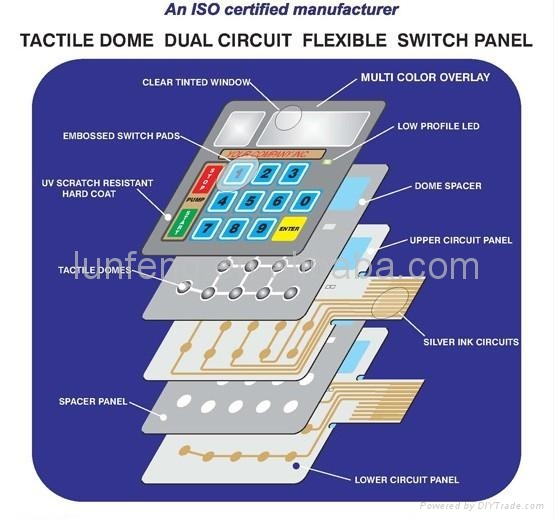The Role of Membrane Switches in Enhancing Device Functionality
The Role of Membrane Switches in Enhancing Device Functionality
Blog Article
Comprehending Membrane Layer Changes: The Trick to Trusted and durable Controls

What Are Membrane Buttons?
Membrane switches are an innovative option in the world of customer interface innovation, integrating capability and style seamlessly. These devices serve as a user interface between users and electronic systems, integrating several parts right into a small format. Commonly created from adaptable, thin layers of materials, membrane switches are developed to respond to touch, allowing users to engage with machinery and electronic tools properly.
The primary elements of a membrane layer button include a printed circuit layer, graphic overlay, and a spacer layer that prevents unplanned activation. The graphic overlay can be customized to show brand name identity or individual choices, enhancing aesthetic appeals while making sure functionality. Membrane layer switches are generally used in different applications, including medical tools, consumer electronic devices, and commercial tools, owing to their durability and resistance to environmental factors such as wetness and dust.
One of the key benefits of membrane layer switches is their ability to hold up against wear and tear, making them suitable for high-traffic environments. Furthermore, they are lightweight and call for minimal space, enabling innovative layouts in item growth. Generally, membrane switches over represent a effective and sensible choice for contemporary electronic interfaces, marrying technology with user-centric design concepts.
Just How Membrane Changes Work
The operation of membrane layer switches hinges on a simple yet reliable system that translates individual input right into digital signals. These buttons contain multiple layers, commonly including a visuals overlay, a spacer layer, and a circuit layer. When an individual presses the switch, the leading layer flaws, permitting a conductive aspect in the circuit layer to reach an equivalent conductive pad on the bottom of the visuals overlay. This contact shuts the circuit and sends a digital signal to the tool, showing that the button has been turned on.
The style of membrane buttons can vary, but they usually include domes or tactile components to give comments to the individual, improving the total experience - membrane switch. The products utilized in membrane layer switches, such as polyester or polycarbonate, add to their longevity and resistance to environmental aspects, consisting of moisture and dust. The published circuits are commonly enveloped, which protects them from wear and tear over time.
Advantages of Membrane Layer Switches

Furthermore, membrane layer buttons are recognized for their toughness. Constructed from durable products, they are immune to dust, dampness, and physical wear, which considerably prolongs their life-span contrasted to conventional mechanical switches. This Click Here longevity makes them particularly ideal for high-traffic atmospheres and applications requiring long life.
An additional substantial benefit is the simplicity of cleaning and upkeep. The smooth surface area of membrane layer switches over lessens dust accumulation and is often unsusceptible spills, making them ideal for settings that require constant sanitization.
Additionally, membrane layer buttons use a streamlined account, bring about a thinner design that can be incorporated into numerous devices without adding mass. This attribute not only boosts the aesthetic allure yet likewise adds to an extra ergonomic item style.
Applications of Membrane Layer Switches
Functional and straightforward, membrane layer buttons find applications across a wide variety of sectors, including clinical gadgets, customer electronic devices, and commercial equipment. In the clinical field, these switches are essential to tools such as analysis tools, person surveillance systems, and infusion pumps, where integrity and ease of cleansing are important. Their capacity to endure severe atmospheres and preserve performance makes them perfect for such applications.

In customer electronic devices, membrane layer switches are made use of in products like microwaves, cleaning machines, and push-button controls - membrane switch. Their sleek layout permits instinctive user interfaces, boosting the general customer experience while offering longevity and resistance to damage
Commercial tools additionally takes advantage of membrane layer switches, specifically in control panels for machinery and automation systems. These buttons offer defense against dirt and dampness, ensuring regular performance in challenging atmospheres. Their customizable features permit suppliers to tailor them to specific functional requirements, improving efficiency and functionality.
Selecting the Right Membrane Layer Switch
When choosing a membrane button, it is necessary to take into consideration various find out here now aspects that influence efficiency and suitability for details applications. The key considerations include environmental conditions, responsive comments, longevity, and layout requirements.
First, analyze the operating environment; switches revealed to moisture, chemicals, or severe temperatures require particular materials to make certain long life and capability. Next off, examine the requirement for responsive feedback. Depending on individual interaction, some applications may gain from a responsive feedback to verify activation, while others may prefer a non-tactile design for aesthetic factors.
Toughness is an additional essential aspect; membrane layer buttons ought to be made to withstand constant use, impacts, and abrasion. More hints Guarantee the picked button can sustain the expected lifecycle, specifically in high-usage scenarios.

Final Thought
In final thought, membrane switches over serve as crucial components in the style of trusted and long lasting control systems across various sectors. The adaptability of membrane layer changes enables for customized remedies that fulfill details functional requirements, strengthening their importance in modern-day technology.
Membrane layer switches over represent an important element of modern-day user interface style, blending performance with durability in various applications.Membrane buttons are a sophisticated service in the world of individual interface technology, incorporating functionality and style flawlessly. Usually constructed from versatile, thin layers of materials, membrane buttons are developed to respond to touch, enabling individuals to connect with machinery and electronic gadgets effectively.
The layout of membrane buttons can vary, however they usually integrate domes or tactile elements to provide comments to the individual, boosting the overall experience.In verdict, membrane changes offer as essential parts in the design of sturdy and trusted control systems across various sectors.
Report this page